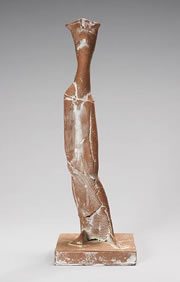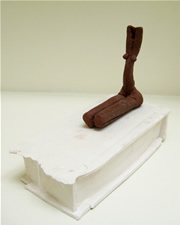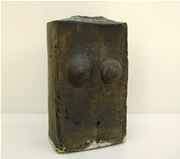MO JUPP (b. 1938)
Mo Jupp was born in 1938 and studied at the Camberwell School of Art and Royal College of Art in London. His first workshop (1967 72) was at Brands Hatch, Kent, and during this period he taught at Harrow, Farnham and Hornsey Schools of Art. He moved to Gloucestershire and then Herefordshire, returning in 1987 to London, where he has a workshop in Bermondsey. He has taught on a regular basis, at Harrow, at the Bristol Polytechnic and the Bath Academy of Art, and has been a visiting lecturer throughout the United Kingdom and Ireland. His work is in the permanent collection of the Victoria & Albert Museum and the National Museum of Wales, Cardiff.
Read more...
As I write I have seen only six of the works destined for Mo Jupp’s new show. These are small-scale figures of women, formed from tubes of clay luted together and, though lacking heads and arms, with breasts and draperies lovingly applied. I have a sense of votive statuettes recovered, incomplete, from some antique midden: testimony to man’s immemorial fascination with woman.
Over the telephone Mo’s voice brings me to earth. His show will be “about women waiting; a little to do with the way women stand.” If he learnt from Hans Coper a respect for Cycladic figures, and himself owns several ancient Cypriot clay statuettes, one of his favourite possessions is a mere bowl from a broken clay pipe that chances to remind him of the human knee. He looks for “an essence, the essence of things,” and fights to stop his work becoming too figurative. If archaeology unearths objects that embody such an essence, he will appropriate the findings. Thus it was with the neatly aligned toes of Egyptian statuary: “So beautiful!” In the last six or eight months he has started looking at Indian sculpture, which previously he found “too hot, almost too up-front.” If some of his new figures sway their hips or wear linear draperies, we may speculate about his visits to the re-opened Indian galleries at the Victoria & Albert.
As for these draperies or skirts, which cover the twiggy legs of his women while yielding a glimpse of tantalisingly bare flank, it is worth recalling that, as a boy, his mother’s work as a dressmaker fascinated him. He often uses dress-making techniques, as in cutting out a “dart” in order to lead his material over a curved form. These skirts also contribute strength of construction to his figures by bridging the gap between the legs. This is important to him because he considers each small figure a maquette that must be capable of realisation the size of life, should a buyer commission such a work.
Mo Jupp began as a sculptor, then trained as a potter, intolerant of the delay in working from clay to bronze. Art or craft? It makes no difference to him. In his fifties, he seems to have shed a youthful need to shock, and now expresses his admiration for women with tender directness: how they stand; what they wear; how they walk through a door. I am impatient to see the rest of his work for this show.
Written by J. V. G. Mallet as the introduction for Mo Jupp’s 1992 exhibition at Galerie Besson.
Exhibitions at Galerie Besson
| Classic & Contemporary Ceramics | Jan - Feb 2006 |
| Summer Show | Aug 2003 |
| Commemorative Mugs for the Millennium | Dec 1999 - Jan 2000 |
| Mo Jupp | Jan - Feb 1992 |



